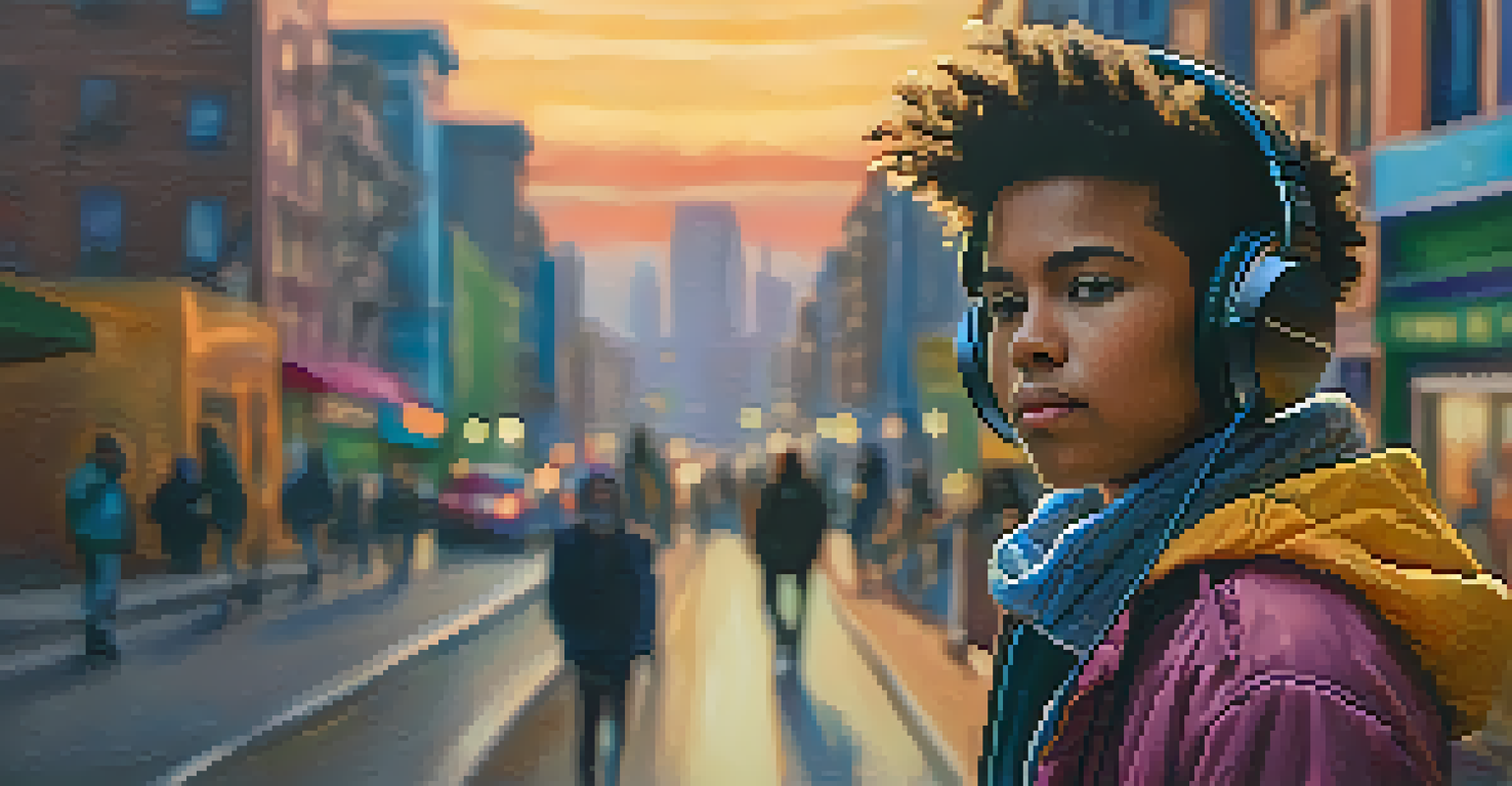The Role of Music in Global Youth Culture Today

Music as a Universal Language for Youth
Music serves as a powerful universal language that transcends borders. For young people, it becomes a way to connect with others regardless of cultural backgrounds. When teens share their favorite songs, they often find common ground, fostering friendships and communities. This shared love for music can lead to conversations about different cultures and experiences, enhancing understanding and empathy among diverse youth.
Music can change the world because it can change people.
Take, for example, the rise of global music genres like K-pop, which has captivated millions worldwide. Fans from various countries unite under a shared fandom, celebrating their mutual interests and creating friendships across continents. This phenomenon illustrates how music can break down barriers and create a sense of belonging among young people who might otherwise feel isolated.
Moreover, the accessibility of music through streaming platforms allows youth to explore a wide array of genres and artists from around the globe. This exposure not only broadens their musical tastes but also enriches their cultural awareness, making them more open-minded and accepting of differences.
Music as a Tool for Self-Expression
For many young people, music is a vital outlet for self-expression. Whether writing lyrics, composing beats, or dancing to their favorite tracks, music allows them to convey emotions and experiences that they might struggle to articulate otherwise. This creative process can be incredibly empowering, helping them to find their voice in a world that often feels overwhelming.

Consider the impact of platforms like TikTok, where users create and share short videos set to music. These snippets often reflect personal stories, struggles, or celebrations, showcasing how music plays a role in their identity. As they engage with these creative outlets, youth not only express themselves but also connect with others who resonate with their experiences.
In essence, music becomes a canvas for young people to explore their identities, making it an essential part of their journey toward self-discovery. Anthems of empowerment and resilience often emerge from this creative expression, inspiring others to embrace their individuality.
The Role of Music in Social Movements
Music has always been a catalyst for social change, and today's youth are no exception. From protest songs to viral challenges on social media, music amplifies voices advocating for justice and equality. Young people harness the power of music to inspire action and raise awareness about pressing issues such as climate change, racial equality, and mental health.
Where words fail, music speaks.
A prime example of this is the use of music at protests, where songs become rallying cries for movements. Whether it’s an iconic anthem from the past or a newly penned track, the emotional resonance of music can galvanize people to unite for a common cause. This connection creates a sense of urgency and solidarity, empowering youth to take a stand.
Furthermore, artists often use their platforms to speak out on societal issues, encouraging their fans to engage in activism. When young listeners see their favorite musicians advocating for change, it can inspire them to get involved, fostering a generation that is not only aware but passionate about making a difference.
The Influence of Technology on Music Consumption
The landscape of music consumption has drastically evolved with technology, shaping how youth engage with music. Gone are the days of waiting for radio play or buying physical albums; today’s youth have instant access to millions of songs at their fingertips. This shift has transformed not only how they listen but also how they discover new music and artists.
Streaming services like Spotify and Apple Music offer personalized playlists and recommendations, making it easier for youth to explore diverse genres. As a result, young listeners are exposed to an array of sounds that they may not have encountered otherwise. This democratization of music allows for a richer and more varied musical experience, catering to individual tastes.
Moreover, social media platforms play a crucial role in promoting new music and trends. Viral challenges and dance routines can propel songs to popularity overnight, showcasing how technology influences not just consumption but also the creation and sharing of music.
Music and Mental Health Awareness
In recent years, the conversation around mental health has gained significant traction, and music plays a pivotal role in this dialogue. For many young people, music serves as a source of comfort and solace during tough times. Listening to songs that resonate with their feelings can be incredibly therapeutic, providing a sense of connection when they feel alone.
Numerous artists openly discuss their mental health struggles through their lyrics, helping to destigmatize these conversations. By sharing their experiences, they encourage young listeners to seek help and talk about their own challenges. This openness fosters an environment where mental health is prioritized, making it easier for youth to navigate their emotions.
Additionally, music therapy has emerged as a beneficial tool for improving mental well-being. Engaging with music—whether by playing an instrument, singing, or dancing—can help alleviate anxiety and depression, reinforcing the idea that music is not just entertainment but a valuable resource for emotional healing.
Music Festivals as Cultural Gatherings
Music festivals have become more than just concerts; they are cultural gatherings that celebrate diversity and creativity. For young people, attending these events provides an opportunity to immerse themselves in a shared love for music while experiencing different cultures. Festivals not only showcase a variety of artists but also create spaces for community and connection.
Think about major festivals like Coachella or Glastonbury, where attendees come from all walks of life. These gatherings foster a sense of belonging and acceptance, allowing youth to express themselves freely and connect with others who share their passion for music. The vibrant atmosphere encourages creativity and collaboration, making it a memorable experience.
Moreover, festivals often incorporate art, food, and workshops, enhancing the cultural experience. This multi-faceted approach helps youth appreciate the interconnection between music and other forms of expression, promoting a holistic understanding of culture.
The Future of Music in Youth Culture
As we look ahead, the role of music in global youth culture will undoubtedly continue to evolve. With advancements in technology and changing social norms, new genres and forms of expression will emerge. Young people will likely drive these changes, using music as a medium to reflect their identities and aspirations in an increasingly connected world.
Innovations like virtual concerts and augmented reality experiences are already shaping how youth engage with music. These technologies offer unique opportunities for interaction and participation, allowing fans to experience performances in ways that were once unimaginable. The future of music will likely be characterized by even greater interactivity, making it more accessible and personal than ever before.

Ultimately, music will remain a constant thread in the fabric of youth culture, serving as a powerful medium for connection, expression, and change. As young people navigate their paths, music will continue to be their soundtrack, shaping their identities and influencing the world around them.